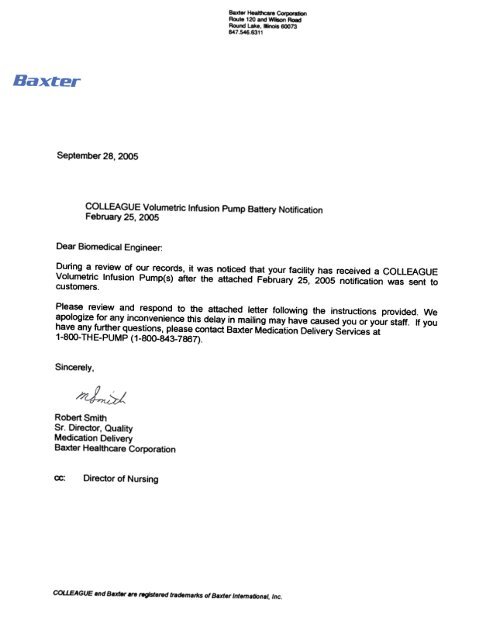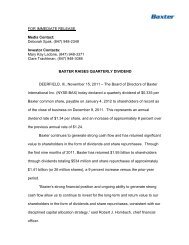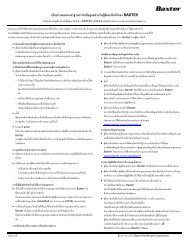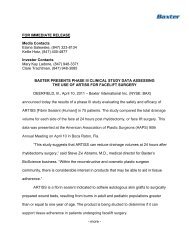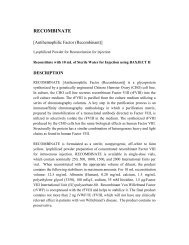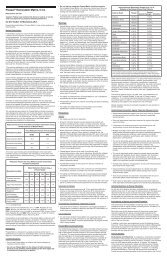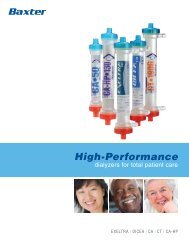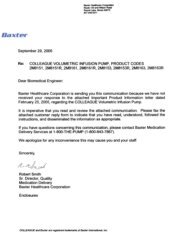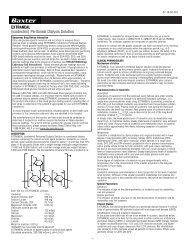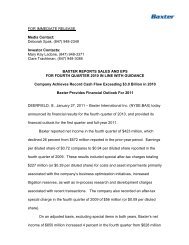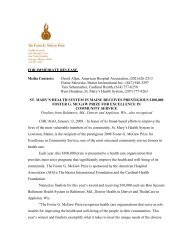Robert Smith Sr. Director, Quality Medication Delivery Baxter ...
Robert Smith Sr. Director, Quality Medication Delivery Baxter ...
Robert Smith Sr. Director, Quality Medication Delivery Baxter ...
You also want an ePaper? Increase the reach of your titles
YUMPU automatically turns print PDFs into web optimized ePapers that Google loves.
September 28, 2005<br />
<strong>Baxter</strong> Heahhcare Corporation<br />
Route 120 and Wilson Road<br />
Round Lake, IMinois 60073<br />
847.546.6311<br />
COLLEAGUE Volumetric Infusion Pump Battery Notification<br />
February 25, 2005<br />
Dear Biomedical Engineer:<br />
During a review of our records, it was noticed that your facility has received a COLLEAGUE<br />
Volumetric Infusion Pump(s) after the attached February 25, 2005 notification was sent to<br />
customers.<br />
Please review and respond to the attached letter following the instructions provided. We<br />
apologize for any inconvenience this delay in mailing may have caused you or your staff. If you<br />
have any further questions, please contact <strong>Baxter</strong> <strong>Medication</strong> <strong>Delivery</strong> Services at<br />
1-800- THE-PUMP (1-800-843-7867).<br />
Sincerely I<br />
<strong>Robert</strong> <strong>Smith</strong><br />
<strong>Sr</strong>. <strong>Director</strong>, <strong>Quality</strong><br />
<strong>Medication</strong> <strong>Delivery</strong><br />
<strong>Baxter</strong> Healthcare Corporation<br />
cc: <strong>Director</strong> of Nursing<br />
COLLEAGUE and <strong>Baxter</strong> are registered trademarlcs of <strong>Baxter</strong> International, Inc.
~<br />
r:,:<br />
i""";1<br />
cc<br />
COLLEAGUE VOLUMETRIC INFUSION PUMP (Battery)<br />
Customer Reply Form<br />
(Important Product Information Letter Dated February 25, 2005)<br />
Facility Name and<br />
Address:<br />
Reply Confirmation !<br />
Completed By:<br />
(Please print name)<br />
Title:<br />
(Please o!i!!!L<br />
Telephone Number<br />
(including Area Code)<br />
We understand the contents of the letter and have disseminated this information to our<br />
staff and to other services, facilities, or home patients, as applicable.<br />
Signature/Date:<br />
(REQUIRED FIELD)<br />
To order the battery harnesses with protection circuit: Please complete additional<br />
information below<br />
Please send battery harnesses with protection circuit (part number BHRNSKlT) for the number of I<br />
infusion pumps listed below:<br />
2M8151 COLLEAGUE Single Channel Infusion Pump<br />
2M8153 COLLEAGUE 3 Channel Infusion Pump<br />
2M8161 COLLEAGUE CX Single Channel Infusion Pump<br />
2M8163 COLLEAGUE CX 3 Channel Infusion Pump<br />
COLLEAGUE and <strong>Baxter</strong> are registered trademarlcs of <strong>Baxter</strong> International, Inc. 2005-011 MD.
<strong>Baxter</strong><br />
February 25, 2005<br />
BaXlet'H88IIM:8reCorporalkxl<br />
RCXII8 120 & WIIIon ~<br />
Rcx.Id L-.. I~ a73-O49O<br />
847.546.6311<br />
Re: COLLEAGUE VOLUMETRIC INFUSION PUMP, PRODUCT CODES<br />
2M8151, 2M8151R, 2M8161, 2M8161R, 2M8153, 2M8153R, 2M8163, 2M8163R<br />
Dear Biomedical Engineer'<br />
<strong>Baxter</strong> Healthcare Corporation is sending you this letter to provide you with important<br />
supplemental infonnation to the letter dated January 21, 2003, regarding sealed lead-acid<br />
batteries used in the COLLEAGUE family of infusion pumps. Key points from this information are<br />
provided below. An Operator's Manual Addendum is enclosed and should be distributed within<br />
your facility. as appropriate.<br />
BatteN Service Life. Reolacement and Pumo StoraCE<br />
. A lead-acid battery has 68 or more full discharge/recharge cycles during its service life.<br />
In the Operator's Manual Addendum are recommendations for optimizing the battery<br />
service life.<br />
. The more often a battery is cycled, the. sooner it will require replacement.<br />
. Always replace both batteries at the same time, with two new batteries.<br />
. Never store the pump unplugged and powered on. The batteries may discharge<br />
completely, resulting in permanent damage. For pump and battery storage<br />
recommendations, please see the enclosed Operator's Manual Addendum.<br />
Swollen Batterv<br />
. At the end of a battery's life, swelling can occur. While we have not received any reports<br />
of adverse events related to the swelling of batteries, the pump case can become hot to<br />
the touch and internal pump damage can occur.<br />
. Swelling can be prevented if both batteries are replaced before the end of their useful<br />
lives and can be postponed by good battery charging and pump usage patterns.<br />
. COLLEAGUE pumps listed on the table below have been manufactured with an<br />
overcurrent protection circuit in the battery harness. This overcurrent protection circuit<br />
provides integral fuses and diodes to help protect the batteries from overcurrent damage<br />
and swelling during charging.<br />
COLLEAGUE Bnd <strong>Baxter</strong> we registered trademarlcs of &xter IntemationBl, Inc. 2005-011 MD.
In February 2005, we implemented replacing the battery harness in our Repair Service<br />
Depot operations. Any pumps that require battery replacement will receive the battery<br />
harness with overcurrent protedion circuit as they are processed through our service<br />
centers.<br />
We encourage your institution to install the battery harness during routine battery<br />
replacement or as part of the device's recommended annual preventative cycle. The<br />
battery harness with the overcurrent protedion circuit will be provided at no additional<br />
charge. Please follow the instructions on the reply form to place an order for the harness.<br />
Initially, we will have a limited number of battery harnesses with overcurrent protection<br />
circuit, and circumstances may require us to partially fill your order.<br />
Excessive Discharoe<br />
. Damaging discharges may occur when the pump is left on battery power for an extended<br />
period of time after the 'Battery Depleted' alarm occurs.<br />
. When batteries become damaged due to excessive discharge, the battery indicator will<br />
overstate the amount of charge remaining.<br />
. As a reminder, you must connect the pump to AC power when the Battery Low Alert<br />
occurs. While in Battery Alert, a properly maintained battery will provide approximately<br />
30 minutes of infusion time left.<br />
. Damaged batteries do not impact the pump's ability to function properly while on AC<br />
power, provided that no other failures or alarm conditions are present.<br />
. During preventive maintenance, it is important to look in the Battery and Pump History<br />
service screen to identify the number of discharges below the alarm threshold. If more<br />
than one excessive discharge is listed in the battery history log, we recommend testing or<br />
replacing both batteries. Specifics conceming preventative maintenance and battery test<br />
linstallation instructions are listed in the product Service Manual.<br />
. Future software updates will address the issue of battery damage due to excessive<br />
discharge. You will be notified when the software is available.<br />
Please complete the attached reply fonn, confinning your receipt of this letter, and fax it back to<br />
<strong>Baxter</strong> using the number provided. To order battery harnesses with protection circuit, please<br />
complete the additional infonnation requested on the reply fonn.<br />
If you have questions concerning this communication, please contact <strong>Baxter</strong> <strong>Medication</strong> <strong>Delivery</strong><br />
Services at 1-800- THE-PUMP (1-800-843-7867). If you have provided COLLEAGUE devices to<br />
other services, facilities, or home patients, please forward this infonnation as appropriate. The<br />
Food and Drug Administration has been advised of this communication.<br />
We appreciate your time and attention to this communication.<br />
Sincere~~<br />
-al~<br />
Vice President, <strong>Quality</strong><br />
<strong>Baxter</strong> Healthcare Corporation<br />
<strong>Medication</strong> <strong>Delivery</strong> Division<br />
Enclosure: COLLEAGUE Operator's Manual Addendum<br />
COLLEAGUE and <strong>Baxter</strong> are registered trademarlcs of <strong>Baxter</strong> International, Inc. 2005-011 MD.
<strong>Baxter</strong><br />
Authorized Representative:<br />
I.A.<br />
B- 7860 Less/nes<br />
... Hnlthc-. c.,..ti8n<br />
Deerfield,lL 60015 USA<br />
Q CopyrVlt 2003 <strong>Baxter</strong> HealtlXa'e Corporation. AllII;a ~<br />
<strong>Baxter</strong> am ca~ are trDmarks 01 <strong>Baxter</strong> IIB1BIiM8III1:.<br />
Please read this addendum!<br />
. It applies to all Colleague pumps, all Colleague 3<br />
pumps, all Colleague CX pumps, and all Colleague 3 CX<br />
pumps.<br />
. It provides important information added since your<br />
Operator's Manual was printed about maintaining and<br />
caring for the batteries in y?ur Colleague Pump.<br />
. It is a part of your Colleague Pump Operator's Manual.<br />
Keep it with your Operator's Manual. Your manual is<br />
incomplete without this addendum.<br />
. It supersedes Chapter 7 of the Operator's Manual you<br />
received with your pump.<br />
IIIII III 1111 IIII!IIII II<br />
*O719A4083%*<br />
Revision A<br />
January 2003
*<br />
This manual was printed on paper stock containing a percentage of recycled fiber.
Cleaning Overview<br />
Recommended Cleaners<br />
The exterior of the pump may be cleaned with a soft cloth, sparingly<br />
dampened with any of the cleaners listed below. Do not spray cleaners<br />
djrectly into the tubing channel or the area where the power cord<br />
enters the pump. Do not use hard instruments for cleaning. Follow<br />
the manufacturer's dilution instructions for concentrated cleaners.<br />
Always clean/disinfect the pump after each use. For a pump that has<br />
been in an Isolation Area. select those agents from the list below mat<br />
both clean and disinfect<br />
The pump's design safeguar~ against fluid spillage into the pump<br />
module. Contoct your <strong>Baxter</strong> Service Center for assistance immediately<br />
if fluid enters the tubing channel. The tubing channel should be cleaned<br />
as soon as possible by authorized service personnel to minimize<br />
potential difficulties caused by fluid pooling and drying on the<br />
mechanism. See "Authorized Service Centers," 10-2.<br />
The following cleaners were tested on the pump:<br />
. Soapy water<br />
. A solution of 10% bleach and water<br />
. Isopropyl alcohol up to 95%<br />
. LpH, by Steris Corporation<br />
. Cidex 7, by Johnson & Johnson<br />
. Super Edisonite, by Brand GmbH<br />
. TOR, Hi-Tor Plus, Huntington Professional Products<br />
. Bafix, Hysan Corporation<br />
07-19-.44-083 COLlEAGUE ~lUMETRIC INFUSION PUMP OPERATOR'S MANUAl ADDENDUM 7-1
7<br />
Preventive Maintenance<br />
Preventi ve Maintenance<br />
Do not clean, disinfect, or sterilize any part of the pump by autoclaving or with<br />
ethylene oxide gas. Doing so may damage the pump and void the warranty.<br />
Only external parts of the pump should be disinfected.<br />
Do not use the following chemicals on the pump, as they will damage the front<br />
panel: acetone, acetoaldehyde, ammonia, benzene, hydroxy toluene, methylene<br />
chloride, and ozone. Do not use cleaners containing n-alkyl dimethyl<br />
ethyl benzyl ammonium chloride unless they appear in the list of recommended<br />
cleaners above.<br />
The table below contains a schedule of basic maintenance tasks that<br />
should be performed on the pump. If the pump cannot be cleaned using<br />
the basic methods described earlier or components are missing or<br />
damaged, discontinue use and notify the appropriate authorized service<br />
personnel. To contact <strong>Baxter</strong> for authorized service or repair, see<br />
"Service lnfonnation," 10.2.<br />
07-19-A4-GS3
Maintenance and Storage Battery Care Infonnation<br />
Battery Care Information<br />
Battery Service Life<br />
The pump can be battery-powered in emergency situations and while<br />
transporting patients. When battery-powered, the Battery icon ~ lit. To<br />
check the charge level of the batteries, access the Battery OIarge Level<br />
d~play via the Options Menu. See "OIecking Baltery Charge Level,"<br />
4-5 for details.<br />
The following infonnal.ion is intended to assist in optimizing the<br />
perfOl"Dlance and service life of the Colleague infusion pump's primary<br />
batteries. Routine battery care enhances battery perfonnance, which<br />
helps ensure optimal PJmp performance.<br />
Service life is the time a battery can be dischalged and recharged to<br />
useful capocity. While lead-acid baneries are rechargeable, in the course<br />
of use they gradually lose the chemical electrolytes needed to recharge<br />
them to useful capacity. When a battery reoches the point in its service<br />
life where it is DO longer capable of being recharged to a level adequate<br />
to operate the devjce, it must be replaced.<br />
Factors that most commonly affect battery life are as follows<br />
. Frequency of dischaJge/recharge<br />
A lead-acid battery has 68 or more full discharge/recharge cycles<br />
during its service life. The more often a battery is cycled, die<br />
sooner it requircs replacement.<br />
. Depth of discharge<br />
The more often a lead-acid battery is discharged to a low battery<br />
or deep discharge state, the sooner it requires replacement.<br />
. Leaving batteries in a discharged condition<br />
If a battery is less than fully charged, and dIe pump is not<br />
connected to AC power, battery damage can oa:ur within hours.<br />
In a less dIan fuUy charged state, the battery undergoes chemical<br />
changes that produce sulfate and lead precipitate. These chemical<br />
changes severely redoce the battery recharge capability.
7 Battery Care Information<br />
Optimizing Battery Service Life<br />
Battery Preventive Maintenance Program<br />
Charging the Batteries<br />
-<br />
Ensuring the following procedures are a part of routine device use can<br />
optimize battery service life:<br />
. Connect pumps to AC power at all times except in the event of<br />
AC power loss or short-term portable operation.<br />
. Store pumps plugged in to AC power to maintain the battery<br />
charge whenever possible. See the Storage Temperature table in<br />
dtis chapter for information on the effects of temperature on the<br />
b"attery storage time.<br />
. Notify Central Supply or other appropriate departments as soon as<br />
a pump is removed from patient use so that it can be cleaned and<br />
the batteries can be recharged.<br />
. Recharge a pump that is in the Battery Low alert condition for a<br />
minimum of 12 uninterrupted lK>urs.<br />
The most reliable way to check the condition (capacity) of the pump's<br />
batteries at any time during their life is to measure discharge time. The<br />
batteries should provide an operating ti~ of no less dIaD 25 hours<br />
(Colleague pump) or 2 hours (Colleague 3 pump) from fully charged to<br />
Battery Depleted alarm wIY:n all channels infuse at 100 mI.Jbr on<br />
battery power. This test is described in the Colleague Pump Global<br />
Service Manual. Battery packs that do not pass the test are at the end of<br />
their service life and must be replaced. Implementing a program to<br />
replace the batteries prior to the projected end of their service life can<br />
reduce battery problems.<br />
For OOditional infomJation about Iead-ocid battery use in <strong>Baxter</strong> infusion<br />
devices, contact <strong>Baxter</strong> <strong>Medication</strong> <strong>Delivery</strong> Services at<br />
1-800- THE-PUMP.<br />
The batteries are charging whenever the pump is plugged into a 100-120<br />
VAc. 5
Disposing of Used Batteries<br />
Storage<br />
Storage<br />
In general, the more often the batteries are discharged and recharged, the<br />
sooner they will need to be replaced. Batteries should only t>e replaced<br />
by <strong>Baxter</strong> authorized service personnel. Always replace both<br />
batteries at the same time, with two new batteries manufactured<br />
within three montllS of one another.<br />
Call your authorized <strong>Baxter</strong> Service Center (see "Warranty and Service<br />
Information," 10-1) to obtain replacement batteries (<strong>Baxter</strong> part number<br />
500948(XX) 1).<br />
The pump's sealed lead acid batteries should not be disposed of in the<br />
trash. They may be disposed of in accordance with local regulations or<br />
returned to your authorized <strong>Baxter</strong> Service Center marked "FOR<br />
DISPOSAL."<br />
Never store the pump unplugged and powered on. The batteries may<br />
discharge completely, permanently damaging them.<br />
Store the pump under the following conditions to maximize banery life.<br />
. Store the pump with its power cord plugged into an AC outlet to<br />
maintain the batteries at full charge whenever possible. Doing so<br />
will maintain the batteries at full charge.<br />
. Ideal storage temperature is noffilal room ambient conditions, at<br />
300 C (860 F) or lower. Storing the pump at higher temperatures<br />
will not damage the batteries as long as the pump is plugged in<br />
during storage or the batteries are fully recharged at the intervals<br />
shown in the table below.<br />
. Never store the pump with the ON/OFF CHARGE key ON and the<br />
pump unplugged. The batteries may discharge completely,<br />
permanently damaging them.<br />
. If pumps must be stored unplugged, fully recharge their batteries<br />
at the intervals shown in the first row of the table below,<br />
according to the temperature of the storage area.<br />
. Recharge spare batteries or batteries removed from pumps at the<br />
intervals shown in the bottom row of the table, according to the<br />
temperature of the storage area.<br />
7-5
7<br />
Storage<br />
. Storing pumps at temperatiJres greater than 30° C (86° F) without<br />
recharging the batteries at the intervals shown in the table will<br />
hasten battery discharge, which may shorten the batteries' overall<br />
operating life.<br />
. Pumps or batteries stored at temperatures below freezing<br />
(0° C or 32° F) must be warmed to room temperature before using<br />
the pump.<br />
. When unpackaged, ensure the pump is stored in a clean and dry<br />
(20-95% RH, non-condensing) environment to safeguard against<br />
prolonged exposure to dust and moisture. In conditions falling<br />
outside the Environmental Operating Limits (see "Technical<br />
Specifications," 8-1), <strong>Baxter</strong> recommends that the pump be<br />
repackaged in the original shipping materials.<br />
7-6 COLLEAGUE VOLUMETRIC INFUSION PUMP OPERATOR'S MANUAl ADDENDUM<br />
07-19-A4-083


